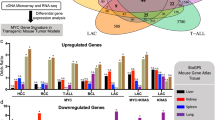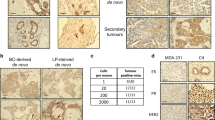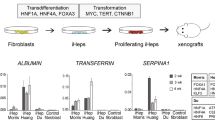Abstract
The identification and isolation of oncogenes capable of inducing malignant transformation on transfection into rodent cells from human tumour cells has opened the possibility of deciphering the processes involved in human carcinogenesis. With the exception of three human lymphomas1, the human transforming genes so far identified have been detected in established tumour cell lines1–8, raising the possibility that they might have been activated during in vitro manipulation of the cells. However, we report here that unmanipulated human solid tumours, including carcinomas of the colon (two), lung and pancreas and an embryonal rhabdomyosarcoma, also contain dominant transforming genes. The carcinomas of the lung and pancreas and the rhabdomyosarcoma possessed a common oncogene which, like that isolated from human LX-1 lung carcinoma cells9, shares sequences with the onc gene of the Kirsten strain of murine sarcoma virus (MSV). We also show that several other human tumour cell lines, including those established from carcinomas of the colon (A2233), lung (A427 and A2182), gall bladder (A1604) and urinary bladder (A1698), possess the same oncogene. Thus a variety of human tumours, regardless of their clinical manifestations, contain a common transforming gene.
This is a preview of subscription content, access via your institution
Access options
Subscribe to this journal
Receive 51 print issues and online access
$199.00 per year
only $3.90 per issue
Buy this article
- Purchase on Springer Link
- Instant access to full article PDF
Prices may be subject to local taxes which are calculated during checkout
Similar content being viewed by others
References
Lane, M. A., Sainten, A. & Cooper, G. M. Cell 28, 873–880 (1982).
Shih, C., Padhy, L. C., Murray, M. & Weinberg, R. A. Nature 290, 261–264 (1981).
Krontiris, T. G. & Cooper, G. M. Proc. natn. Acad. Sci. U.S.A. 78, 1181–1184 (1981).
Lane, M. A., Sainten, A. & Cooper, G. M. Proc. natn. Acad. Sci. U.S.A. 78, 5185–5189 (1981).
Murray, M. J. et al. Cell 25, 355–361 (1981).
Perucho, M. et al. Cell 27, 467–476 (1981).
Smith, B. L., Anisowicz, A., Chodosh, L. A. & Sager, R. Proc. natn. Acad. Sci. U.S.A. 79, 1964–1968 (1982).
Pulciani, S. et al. Proc. natn. Acad. Sci. U.S.A. 79, 2845–2849 (1982).
Der, C. J., Krontiris, T. G. & Cooper, G. M. Proc. natn. Acad. Sci. U.S.A. 79, 3637–3640 (1982).
Graham, F. L. & van der Erb, A. J. Virology 52, 456–467 (1973).
Wigler, M. et al. Cell 11, 223–232 (1977).
Goldfarb, M., Shimizu, K., Perucho, M. & Wigler, M. Nature 296, 404–409 (1982).
Shih, C. & Weinberg, R. A. Cell 29, 161–169 (1982).
Parada, L. F., Tabin, C. J., Shih, C. & Weinberg, R. A. Nature 297, 474–478 (1982).
Santos, E., Tronick, S. R., Aaronson, S. A., Pulciani, S. & Barbacid, M. Nature 298, 242–247 (1982).
Ellis, R. W. et al. Nature 292, 506–511 (1981).
Andersen, P. R. et al. Cell 26, 129–134 (1981).
Shih, T. Y., Weeks, M. O., Young, H. A. & Scolnick, E. M. Virology 96, 64–79 (1979).
Shilo, B. Z. & Weinberg, R. A. Nature 289, 607–609 (1981).
Peto, R. in Banbury Report 9: Quantification of Occupational Cancer (eds Peto, R. & Schneiderman, M.) 269–284 (Cold Spring Harbor Laboratory, New York, 1981).
Bubenik, J. et al. Int. J. Cancer 11, 765–773 (1973).
Giard, D. J. et al. J. natn. Cancer Inst. 51, 1417–1423 (1973).
Rasheed, S., Nelson-Rees, W. A., Toth, E. M., Arnstein, P. & Gardner, M. B. Cancer d33, 1027–1033 (1974).
Southern, E. M. J. molec. Biol. 98, 503–517 (1975).
Tsuchida, N., Ryder, T. & Ohtsubo, E. Science 217, 937–939 (1982).
Barbacid, M., Lauver, A. L. & Devare, S. J. J. Virol. 33, 196–207 (1980).
Bonner, W. M. & Laskey, R. A. Eur. J. Biochem. 46, 83–88 (1974).
Author information
Authors and Affiliations
Rights and permissions
About this article
Cite this article
Pulciani, S., Santos, E., Lauver, A. et al. Oncogenes in solid human tumours. Nature 300, 539–542 (1982). https://doi.org/10.1038/300539a0
Received:
Accepted:
Issue Date:
DOI: https://doi.org/10.1038/300539a0
This article is cited by
-
Emerging evidence and treatment paradigm of non-small cell lung cancer
Journal of Hematology & Oncology (2023)
-
The phosphorylation of PHF5A by TrkA-ERK1/2-ABL1 cascade regulates centrosome separation
Cell Death & Disease (2023)
-
Development of a Cell Line Containing the Chimeric ETV6-NTRK3 Gene. The Search for Mutations of the Tyrosine Kinase Chimeric Domain That Cause Resistance to Larotrectinib
Bulletin of Experimental Biology and Medicine (2023)
-
Japanese Society of Medical Oncology/Japan Society of Clinical Oncology/Japanese Society of Pediatric Hematology/Oncology-led clinical recommendations on the diagnosis and use of tropomyosin receptor kinase inhibitors in adult and pediatric patients with neurotrophic receptor tyrosine kinase fusion-positive advanced solid tumors
International Journal of Clinical Oncology (2023)
-
NTRK insights: best practices for pathologists
Modern Pathology (2022)
Comments
By submitting a comment you agree to abide by our Terms and Community Guidelines. If you find something abusive or that does not comply with our terms or guidelines please flag it as inappropriate.



